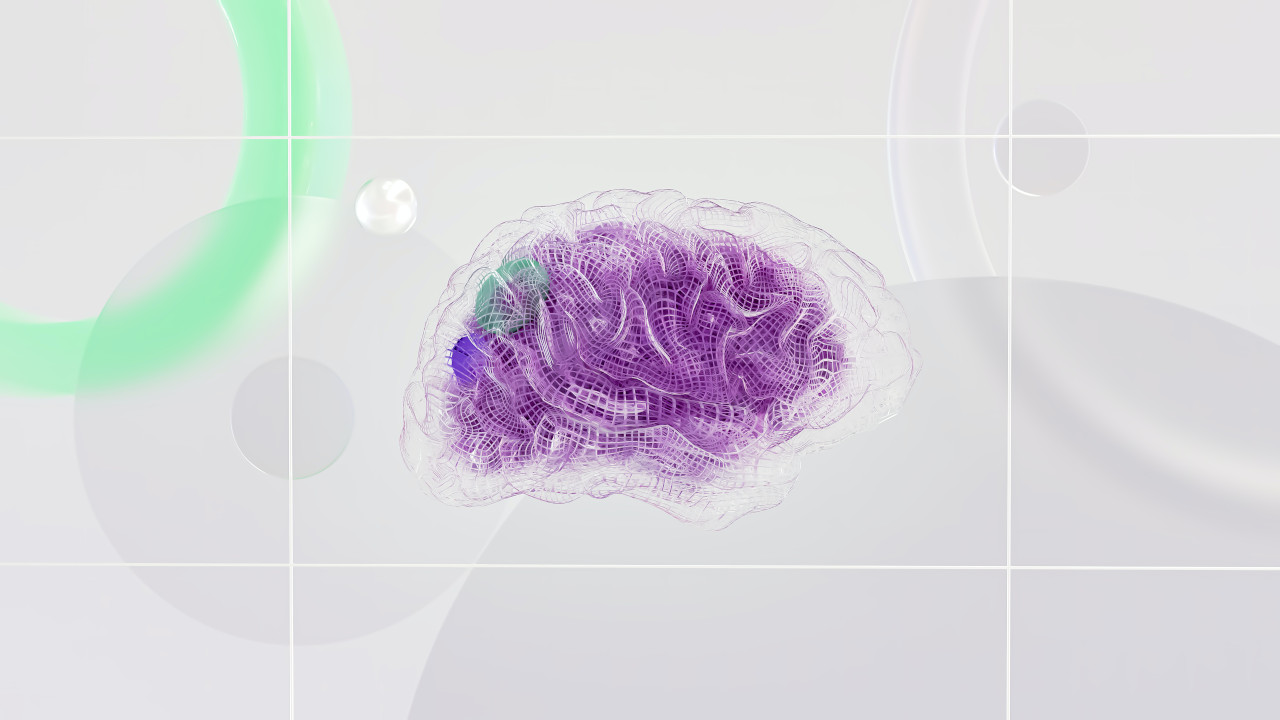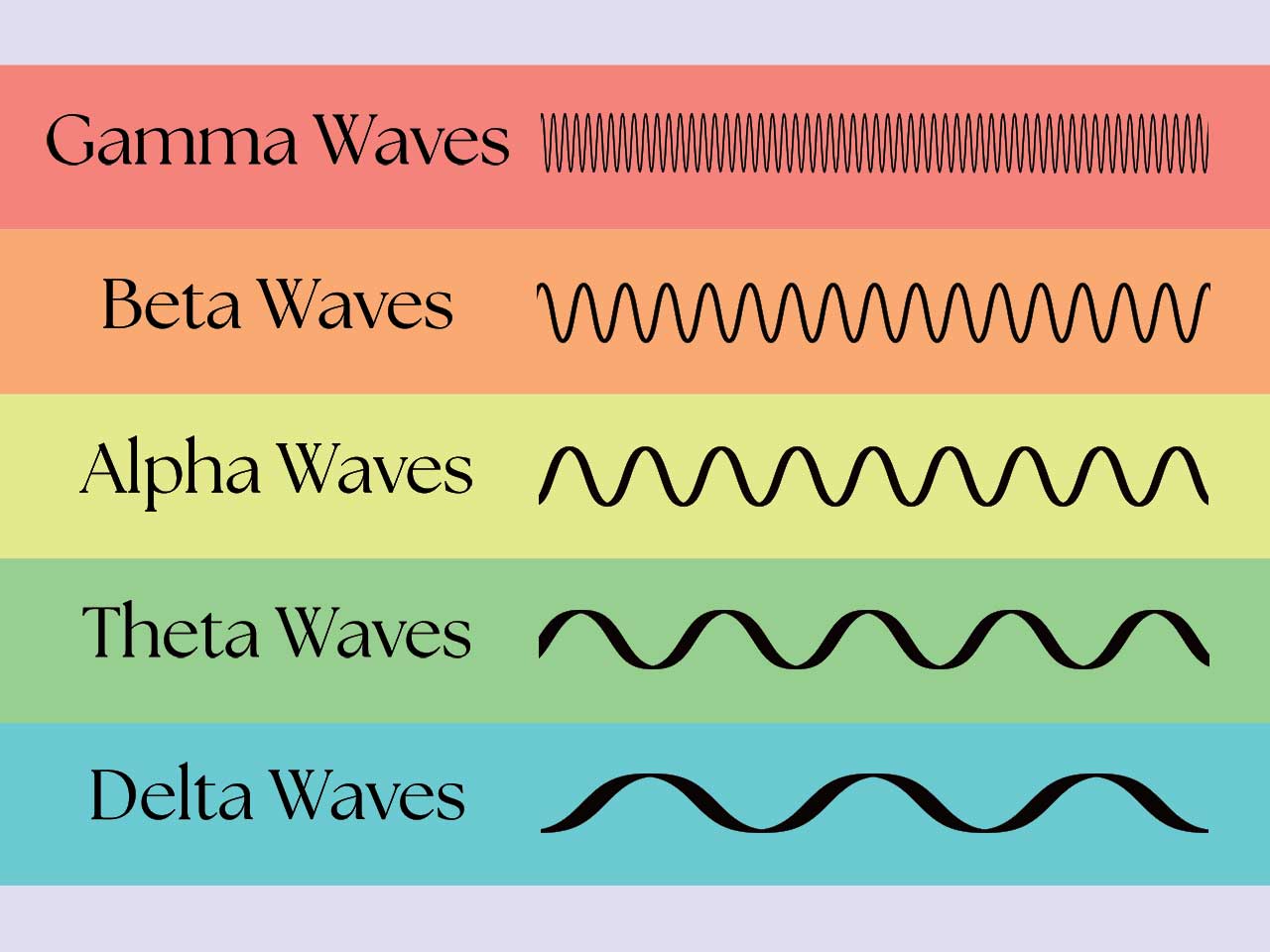Take a high-level look at the activity in your brain and you’ll find oscillations bouncing back and forth between voluminous groups of neurons.
This is how your brain talks to itself, organizing the regions responsible for sensing, thinking, and acting in ways that you need to achieve your goals.
These brain waves scale from the low-level delta waves or 0.5 cycles per second, all the way up to gamma waves of 100 or more cycles per second.
The different frequencies relate to our mental energy levels—the slow waves are found when we’re sleepy, relaxed, and not focusing on much; high-frequency brain waves are behind more focused attention and problem-solving.
Alpha brain waves are in the middle of the spectrum, occupying the 8 – 12 Hz range. If ever there was a state we should be spending more time in, it’s the alpha state of mind.
What’s So Great About Alpha Waves?

Alpha brain waves are characterized by an alert yet calm mind.
You’re not so relaxed you could go to sleep, but you’re also not too burdened by circumstances or thoughts. It strikes a perfect balance between them.
Occupying that space between intently focused and sleepily unaware is a creative oasis. The mind has the freedom to roam and the energy to do so.
Research backs this point up. A 1978 study found alpha brain waves correlated with creative inspiration. Other researchers applied a current to the frontal cortex of the participants, which increased their creativity.
Beyond boosting creativity, an alpha state of mind is a calming and restorative state. It’s been found to alleviate symptoms of both major depressive disorder and generalized anxiety disorder.
So now that you know why you should, here are 10 ways to enter the Alpha state of mind:
1. Meditation
While there are many forms of meditation, most of them help to settle the mind into a state of calm awareness—precisely what the alpha state of mind is all about.
For that reason practicing meditation, in general, is likely to help you generate alpha brain waves, so you can find and rely on the method that you prefer.
However, if you’re just starting out with meditation or you want to know which varieties have been directly linked to alpha brain waves, here are some options:
A number of studies have found increases in both alpha and the slightly lower theta bands during non-directive meditation. This often involves repeating a mantra, but the main point is to let your mind wander, not to force it on anything.
Other research found higher alpha activity in people practicing Vipassana meditation, which asks you to observe your inner self without judgment or forceful control over your attention.
2. Flow
Also known as being in the zone, the state of flow occurs when we engage in a task that perfectly balances difficulty with our ability to overcome it.
In flow you often lose your sense of time, your inner critic goes quiet and your attention is consumed entirely. Often described as an intensely rewarding experience, you will find people who live to find it.
Some people look towards extreme activities like sky diving, surfing massive waves, or hitting incredible speeds on bikes.
But these aren’t necessary, you can also find flow by playing games, going for a run, writing an article, or just about anything, provided your skills are stretched to accommodate the activity.
When in flow, your brain is sitting on the border between alpha and theta, around 8 Hz. When you start an activity it might be a little higher, in the beta or gamma realms, but as you settle into the zone they will lower down towards alpha.
If you would like to learn more about your brainwaves and how to tap into the flow state to improve your performance, you can download my Flow Meditation Guide.
3. Binaural Beats
An interesting thing happens when you play two slightly different frequencies in each ear—you hear a beating pattern that is the difference between the two.
That pattern doesn’t exist in the sounds themselves, it’s the result of your brain processing both signals. As your brain talks in waves, sending sound waves in serves to adjust your brain waves to those sound waves.
This phenomenon is called brainwave entrainment, and binaural beats are a great way to use it to promote alpha brain waves.
For instance, if you play frequencies of 250 Hz and 258 Hz into your left and right ears, your brain will perceive a beat of 8 Hz—the beginning of the alpha band.
You can find many binaural beats on Youtube or Spotify as well as specific apps, just remember: they all require headphones to play the different sounds into each ear.
To learn more about brainwave entrainment you can read my guide to binaural beats.
4. Isochronic Tones
Like binaural beats, isochronic tones are used for brainwave entrainment, but where binaural tones and continuous, isochronic tones are stuttered.
Rather than using two slightly different frequencies to create a beating pattern, isochronic tones are short bursts of a single tone, repeated quickly enough to form a rhythmic pulse.
Playing these beating tones causes your brainwaves then sync with them through the same entrainment mechanism, so the 8 – 12 Hz frequency will help lead you into the alpha state of mind.
While binaural beats require the use of headphones for alpha brainwave entrainment, isochronic tones are a single frequency that can be listened to with speakers.
5. Silva Method
The Silva Method is a mixture of meditation techniques and exercises developed by Jose Silva in the 1940s. It’s now been translated and taught across the world.
It is designed to help people get into the alpha state and improve their creativity and intuition. They call it mind control—not the sci-fi idea of controlling other peoples’ minds, but getting a better grasp of your own.
Given there are workshops on the Silva Method, it won’t be surprising that we can’t give you a full rundown here. For a longer rundown of the Silva Method, you can watch their masterclass on how to access altered states of mind.
However, it will start with meditation to bring your mind into a calm and relaxed alpha state. This meditation often involves closing the eyelids while directing your eyes at a 20-degree angle, and counting backward from 100 to 1 at 2-second intervals.
Following the meditation, you’ll engage in visualization activities. It’s common for these visualizations to be of reaching certain goals and desires.
6. Wearable Meditation Headbands
What better way to find your way into an alpha state of mind than by watching and responding to your brain waves in real-time?
In the last few years, there’s been a number of excellent wearable meditation headbands released that give you immediate feedback through audio cues designed to help you enter deeper states of meditation.
These at-home neurofeedback training devices give you a chance to peer inside your brain more accurately, and to connect the inner experience you have with the data about which brainwave oscillations are present.
I’ve written a guide to these wearable meditation headbands that outlines the different options currently available and how they can help you improve your meditation practice.
If you’re someone who struggles with meditation and has a difficult time quieting your mind to get into the alpha state then it’s worth trying one of these personalized brainwave training devices.
7. Heartmath Inner Balance
The Heartmath Inner Balance is both an app and a device that attaches to your earlobe so that it can pick up on your heart rate.
The device measures heart rate variability (HRV), which is the change in the timing of your heartbeats. Low variability has been shown to be a risk factor for many illnesses, including major depression and heart attacks.
Things like stress and poor sleep tend to lower our HRV, whereas a high HRV signals greater fitness and resilience to stressors.
HRV can be a proxy for brain wave activity. Lowering brain wave activity also helps lower nervous system activity, as it calms both mind and body.
Whether you practice getting HRV or brain wave activity under control, the other is likely to follow. The Heartmath Inner Balance focuses on the heart rate side of the equation.
8. 4-7-8 Breathwork
Most of the time we breathe automatically, without any awareness of how fast or slow it is. Sometimes taking a more conscious approach is beneficial, after all, this is how we supply oxygen to that all-important organ in our heads.
By slowing your breathing you can promote activity in your parasympathetic nervous system, which decreases activity in the sympathetic nervous system—the one responsible for the fight-or-flight response.
This breathing exercise is based on the pranayama yoga technique and was developed by Dr. Andrew Weil, who described it as a “natural tranquilizer for the nervous system.”
Like other breathing exercises, 4-7-8 breathwork is designed to bring your body and mind into a more relaxed state.
Here’s how you practice it:
- Find a comfortable and distraction-free place to sit down.
- Place your tongue at the top of your mouth against the back of your top teeth.
- Exhale all the air around your mouth
- Close your mouth and inhale through your nose for 4 seconds,
- Hold your breath for 7 seconds
- Exhale from your mouth over 8 seconds, making an audible “woosh” sound.
- Repeat four or more times.
For combining breathwork with brainwave entrainment music, I recommend trying Soma Breath.
9. Forest Bathing
We all know that nature has a profound effect on our mental well-being.
It’s why we populate our homes and gardens with lush greenery and colorful flowers. City streets lined with trees don’t just offer shade but something more aesthetic and refreshing.
Forest bathing takes these psychological benefits seriously, and asks us to get even deeper into the woods, to suck in the clean and rid ourselves of worry.
The idea of forest bathing comes from the Japanese ‘Shinrin-Yoku,’ and it simply asks you to be in nature, to pay attention to your senses and experience. You don’t exercise, you leave your phone and devices at home, and you just be in nature.
Spending a few hours like this has been shown to boost our immune systems by increasing the activity of natural killer cells and anti-cancer proteins. But it’s also just a calming and meditative practice, perfect for promoting those alpha waves.
10. Awe Walks
Awe is a feeling of overwhelming transcendence, when something takes our breath away. It often occurs when something breaks our expectations and challenges our understanding of the world.
You might be in awe of another person, a vast natural space, a building, music, or a religious or supernatural experience, among many other possibilities.
It can seem like awe isn’t something we can cultivate, but rather something that we luck into. However, many of our everyday experiences can result in awe if we simply change how we look at and interpret them.
Awe walks are about going for a stroll and turning a normally mundane experience into something profound.
It will be easier if you can go somewhere new, and somewhere vast. Novelty and a sense of scale are great at encouraging awe. Even if you’re on a well-worn path, try to see things you haven’t noticed before.
Make sure to leave your phone at home, and try not to have a destination and time frame in mind, so you’re free of distractions and able to simply focus on your surroundings and experience.
Tapping Into The Alpha State of Mind
Getting yourself into an alpha state of mind will help you focus in a more relaxed way, promoting creativity while decreasing stress and anxiety.
If you find yourself in flow, engaging in a task with effortless precision and attention, you’ll likely find alpha brain waves playing a large role.
Fortunately, you don’t have to wait for the alpha state of mind to occur naturally, you can take an active part in generating the alpha state in many different ways and with different tools.
The 10 methods presented here offer something for everyone. Devices you can buy that read your mind, simple meditations you can do at home, new ways of looking at the world on a daily walk.
No matter your budget, time frame, or location, there are ways you can get yourself into an alpha state of mind. And it’s well worth it to do so.
- How The Muse S Athena Works For EEG And fNIRS Neurofeedback - April 24, 2025
- The 10 Best Pomodoro Timer Apps For Remote Workers - April 11, 2025
- Hacking The Flow Cycle: Brainwaves, Creativity and Flow States - April 11, 2025





 This website uses cookies to improve your web experience.
This website uses cookies to improve your web experience.